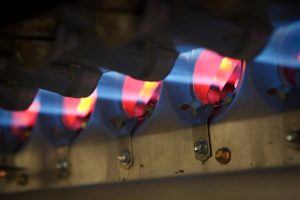 When you’re shopping around for a new furnace, you might start to develop a new vocabulary. There’s the AFUE—Annual Fuel Utilization Efficiency—that helps you determine the efficiency of your new system. And another set of terms you may see used often are as follows: “one-stage,” “two-stage,” and “modulating” furnace.
When you’re shopping around for a new furnace, you might start to develop a new vocabulary. There’s the AFUE—Annual Fuel Utilization Efficiency—that helps you determine the efficiency of your new system. And another set of terms you may see used often are as follows: “one-stage,” “two-stage,” and “modulating” furnace.
You might notice that modulating and two-stage furnaces receive a higher rating for efficiency and performance (or simply find that the price for these units is higher). Wondering why this is? Does a two-stage or modulating furnace really make that much of a difference? Find out in today’s guide to these powerful systems.
One-Stage (Regular) Furnace Operation
The one-stage furnace is the one that most of us are used to (whether we realize it or not). Raising the temperature on the thermostat does not make the furnace get any hotter—it only makes it run for longer. Most furnaces (single-stage furnaces) have one heat level, and that is 100%.
When the furnace cycles on, the burners within light up, and the flame is as high as it can be. When the furnace cycles off, the gas shuts off entirely. There is no in between.
The Problem with One-Stage Operation
This is an effective way to heat a home, but not a particularly efficient way. Most of the time, you’re not trying to heat up your home by 15 degrees. When the temperature on the thermostat drops and the furnace must cycle on, it typically only needs to heat the home by about 1-2°F.
When the flame is turned up to 100%, you often have more heat than you need. It is difficult to heat the home by just one degree, which means it may overshoot the thermostat settings, wasting energy in the process.
Two-Stage Furnace: How It Works
A two-stage furnace solves this problem of inefficiency and discomfort. The flame from the burners is able to adjust to a lower setting because this is often all you need. It requires less fuel to burn, keeping your bills low. Plus, your home will never overheat or have to deal with temperatures dropping too low.
A two-stage furnace can keep up this low output, and is especially efficient when paired with a fan motor with variable speed settings. A variable speed fan allows for multiple speed settings from the blower fan as well, which means heat output through the vents automatically adjusts along with the flame setting.
A Step Beyond: Modulating Furnaces
If you want to do one better than this, a modulating furnace is the way to go. Modulating furnaces have more than two settings, adjusting the flame as needed for the most efficient operation. You can find modulating furnaces with an AFUE rating of well over 95%, for some of the most efficient heating you can find. For more information, contact your local technicians!
Contact Max Sr & Paul Schoenwalder Plumbing, Heating and Air Conditioning, A Corp. today! We install and service furnaces in Union, NJ. Established 1912.
